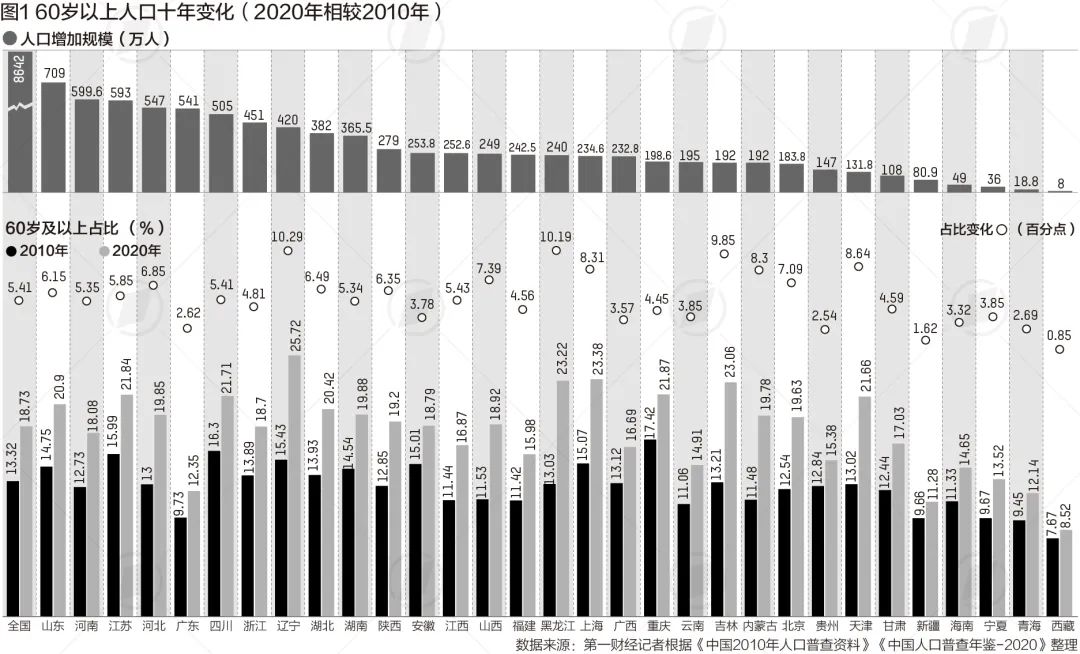my country's elderly population has increased by 86.42 million in ten years, and the elderly employment population has exceeded 66 million
Author:First financial Time:2022.09.23
23.09.2022

Number of this text: 2324, the reading time is about 4 minutes older
Introduction: From 2010 to 2020, 6 provinces 60 and over the elderly population increased by more than 5 million, namely Shandong, Henan, Jiangsu, Hebei, Guangdong, and Sichuan, all of which were the population with a resident population of more than 70 million. Province.
Author | First Finance Lin Xiaozhao
China's population aging is accelerating. In recent years, which provinces have increased their population in the elderly? Which aging proportion increases to a large increase?
First Financial reporter sorted out the "China Population Census Information in China in 2010" and "Chinese Population Census Yearbook -2020" found that in the past ten years, the elderly population in my country increased by 86.42 million, accounting for 5.4 percentage points. In terms of provinces, the number of newly added elderly population in Shandong, Henan, and Jiangsu ranks among the top three. From the perspective of changes in the proportion, the aging of the Northeast, North China and other places has increased significantly. At present, my country's elderly population accounts for 8.8%of the employment population, and the total number of elderly employment population exceeds 66 million. Agriculture, forestry, animal husbandry, fishing, fishing, construction and other industries are major employment areas. In 2020, my country's elderly population reached 264 million, accounting for 18.73%.
The increase in the elderly population in Shandong maximized the increase in the aging of the Northeast
From the perspective of provinces, from 2010 to 2020, 6 provinces 60 and over the elderly population increased by more than 5 million, namely Shandong, Henan, Jiangsu, Hebei, Guangdong, and Sichuan, all of which were permanent. Population province.
Among them, the elderly population in Shandong has increased by 7.09 million in ten years, ranking first, and more than 1 million more than Henan, which is second. From the perspective of the total population of the elderly, in 2020, the elderly population in Shandong reached 21.22 million, which is the only province in the country with a population of more than 20 million. In the past ten years, Henan's population has increased by 5.996 million, ranking second; Jiangsu has increased by 5.93 million in the past ten years; Hebei has increased by 5.47 million.
Although Guangdong's resident population reached 126 million in 2020, the elderly population in the past ten years has only increased by 5.41 million, ranking fifth. On the one hand, nearly 30 million among Guangdong's permanent population flows into the population outside the province, mainly in young adults; on the other hand, some of the registered population in Guangdong are young people who have settled in Guangdong in recent years. At the same time, Chaoshan, Guangdong, Zhanjiang, Maoming and other places in western Guangdong have a strong fertility culture and a high willingness to have fertility. On the whole, the proportion of the elderly population in the household registration population is relatively low.
In 2010, only 5 provinces in my country had more than 10 million elderly population, namely Shandong, Sichuan, Jiangsu, Henan, and Guangdong. By 2020, the provinces with more than 10 million elderly population in my country will increase to 11 provinces, namely Shandong, Jiangsu, Sichuan, Henan, Guangdong, Hebei, Hunan, Zhejiang, Hubei, Anhui and Liaoning.
From the perspective of the population of 60 and over, in 2020, my country's elderly population accounted for 18.73%, an increase of 5.4 percentage points from 2010. From the perspective of provinces, the proportion of the elderly population in 6 provinces increased more than 8 percentage points, namely Liaoning, Heilongjiang, Jilin, Tianjin, Shanghai and Inner Mongolia. In addition, the proportion of the elderly population in Shanxi and Beijing has increased by more than 7 percentage points.
In 2010, 6 provinces accounted for more than 15%of the elderly population, namely Chongqing, Sichuan, Jiangsu, Liaoning, Shanghai, and Anhui. Among them, only Liaoning was located in the northeast. At that time, Heilongjiang ranked 13th and Jilin ranked 11th.
By 2020, a total of 10 provinces with a population of 60 and over the country accounted for more than 20%of the population. The northeast replaced Sichuan and Chongqing to become the highest degree of aging. Among them, Liaoning's elderly population accounted for 25.72%, and Heilongjiang and Jilin also exceeded 23%.

For ten years, the proportion of the elderly population in the Northeast has increased the largest? On the one hand, the first financial analysis of the Northeast Asia Research Institute of Jilin University, on the one hand, the population birth rate in the 1950s and 1960s was high. In recent years, these people have entered the elderly stage one after another. At the same time, due to the economic downturn and the lack of industrial development, employment opportunities have decreased. In recent years, many young people have ran to the southeast coast and other places. The flow of young people has also accelerated the degree of aging. On the other hand, the Northeast industrialization and urbanization were earlier. Enterprises are dominated by state -owned enterprises. Many employees are state -owned enterprises and administrative institutions. The family planning is strictly implemented.
The elderly employment population exceeds 66 million
Under the reality of deepening population aging, in the future, it is necessary to effectively develop the labor force of the elderly and increase the labor participation rate of the elderly. So, what is the current employment of the elderly population in my country?
The National Statistics Bureau recently announced the "Chinese Population Census Yearbook -2020" detailed disclosure of the seventh population census sub-data. In the fourth volume of long table data data, there are employment statistics of the nation's age, gender, and industry. It should be noted that because the census table is sampled by households and registered, the total population and the sampling ratio of various population structure data will be slightly different.
According to this, the first financial reporter calculated that among the total employment population in my country, the ages of 60 and above account for 8.8%, of which 65 and above account for 5%. In other words, one of the 20 employees is 65 or more. According to the data of the Ministry of Human Resources and Social Affairs, as of the end of 2020, there were 750.64 million employees across the country. According to this calculation, in 2020, the elderly employment population in my country exceeded 66 million, accounting for about a quarter of all the elderly population, that is, one of the four elderly people was working. What industry does the elderly employment population mainly engage in? According to the calculations of the first year's yearbook, the number of employees in major industries in my country, the highest population of the elderly is agricultural, forestry, animal husbandry and fishery, accounting for 28.3%, followed by water conservancy, environment and public facilities management industry. The ratio reaches 18.4%.
The proportion of employment population in major industries is largely different. For example, the proportion of agricultural, forestry, animal husbandry and fishery employment population accounts for 20.6%; the manufacturing industry is 18.1%; the wholesale and retail industry is 14.1%; the construction industry is 11.3 %.
According to the proportion of employment population in major industries and the proportion of employment population in major industries, the proportion of the elderly population in the major industries, among the major industries in my country, the elderly employment population of agriculture, forestry, animal husbandry and fishing accounts for the most, accounting for 5.82%of the total employment population, accounting for 66.16%of the elderly employment population. In other words, every three elderly employees are engaged in agriculture, forestry, animal husbandry and fisheries.

So why is this proportion of agriculture, forestry and animal husbandry so high? Professor Dong Yuquan, the Dean of the Population Development Research Institute of Guangdong Province, analyzes the First Financial Analysis. On the one hand, it is difficult for these groups to integrate into the city. Although the level of urbanization is rapidly increasing, most of the elderly people in the agricultural population are still Living in rural areas, there are relatively few workers in the city; the elderly population in the agricultural population has long been engaged in agriculture, forestry, animal husbandry and fishing, and is limited by the conditions of knowledge. The main thing is to engage in agriculture, forestry, animal husbandry and fishing. On the other hand, the elderly in the agricultural population do not have a fixed income (for example, most elderly people in the countryside only have rural basic pensions, about 100 yuan per month), and have to continue to engage in agriculture, forestry, animal husbandry and fishing work to maintain their lives.
In addition, the elderly engaged in the construction industry account for 0.6%of the total employment population and 7.06%of the elderly employment population. The proportion of elderly people engaged in manufacturing, wholesale and retail industry accounts for more than 6%. Coupled with agriculture, forestry, animal husbandry and fishing, the proportion of elderly employment people engaged in these four major industries accounts for 86.7%of the elderly employment population.
Data show that the population between 60 and 69 years old accounts for more than half of the elderly population of 60 and over, with a total of more than 147 million people. A considerable part of them still has the willingness and ability to work. How can the increasingly large and old -age elderly people achieve "old -fashioned"? How to promote the development of human resources for the elderly? Dong Yu said that it is necessary to develop the labor market for the elderly and the elderly, and give full play to the creation value of the labor force of the elderly. In addition, it is necessary to fill in the skill training system for the elderly and elderly people, and improve the urban and rural "lifelong education" system. It is necessary to connect vocational training with employment of the elderly, and different occupations conduct different directions in different directions.
- END -
Is it wrong?The man helped someone to burn the pig's feet and was finally detained for ten days!

Man helps people to burn pig feetEventually detained by administrative detention f...
"Shanxi dialect" | Moon is the Ming hometown

Moon is the hometownJi XianlinEveryone has a hometown. Everyone's hometown has a m...